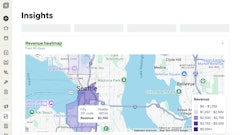
Lawn care and landscaping businesses face a recurring challenge year over year: seasonality.
During the peak season, it's all hands on deck. Teams are working long hours, juggling multiple clients and racing against the clock to meet demand. This high-intensity period can lead to burnout and high turnover rates if not managed carefully.
The off-season brings its own set of hurdles. With the bread-and-butter jobs shuttered until spring, businesses in the green industry may experience employee churn (planned or not) as crews seek employment elsewhere. Fixed costs, such as insurance premiums and equipment leases, can put significant pressure on seasonal businesses during their off-seasons when revenue is lower. It is a cycle that even the most scrupulous of budgets can struggle to proactively manage.
This is why many lawn care companies look for ways to diversify their services or optimize their operations to maintain cash flow throughout the year.
Expanding services for year-round revenue
The nature of seasonal work is a huge contributor to employees leaving the industry altogether. By offering services aligned with different seasons, a lawn care company can help improve steady work for their staff. Some companies tackle this approach by pairing with other seasonal businesses that align with their off season. For example, a lawn care company might pair with a ski resort, allowing employees to seamlessly transition from season to season, knowing they have steady work throughout.
If you’re thinking about possible service diversification, some other potential expansions might include:
1. Snow removal and de-icing in winter months
2. Hardscaping and outdoor living space design
3. “Transitionary” seasonal offerings, like fall cleanup
4. Indoor plant care and maintenance for commercial clients
As you add services to your offerings, though, remember to make sure they complement your existing employee skill set, equipment and supplies inventory and the needs of your customer base. While your off-season services may take off, allowing you to recoup costs on large investments in seasonal-specific equipment, it doesn’t make sense to pour capital into giant, single-purpose machinery if customers aren’t willing to pay for services in that area.
To really understand if expansion makes sense, you may need to conduct market research prior to implementing any new off-season business models, including surveying your current customers to gauge interest in potential new services. Consider starting with low-investment options that leverage your existing resources and expertise. For instance, if you don’t already offer fall cleanup services or winter pruning, this might be a way to test the natural extension of your business offerings without requiring additional equipment. From there, you can gradually expand your offerings, never straying too far from your core competencies.
A successful service expansion does typically require some key technologies to be successful. For example, a lawn care company hoping to expand to winter services will need a customer relationship management system to support business scale as it grows. Other systems to consider might include a routing tool to ensure you’re minimizing travel time and fuel costs, customer management tools to improve communication and service delivery and reporting and analytics tools to help identify trends and areas for even more expansion. The good news is that, usually, a company is using one or all of these types of tools to manage their peak-season demand and the costs would already be included in your fixed expenses year-round.
The introduction of AI for predictive planning
One of the most exciting developments I've seen in recent years is the application of artificial intelligence (AI) to help lawn and landscaping businesses better predict and prepare for seasonal demand. It’s exciting to look ahead and see that, someday in the not-so-distant future, lawn care and landscape companies will be able to analyze historical data, weather patterns and even economic indicators of their consumer base such as spending patterns (data that would eliminate the need to conduct manual surveying of customers), using AI technology integrated with their existing lawn care software systems.
With this insight, business owners will be able to plan staffing levels more effectively, stay ahead of labor costs during slow periods and avoid understaffing during peak times, implement dynamic pricing strategies to maximize revenue year-round and optimize inventory management without dealing with overstocking.
Embracing a year-round mindset
The key to thriving as a year-round lawn care business is to shift from a reactive to a proactive mindset. Rather than viewing the off-season as the quiet before the spring storm, instead look at it as an opportunity to find the right service to compliment your seasonal work within your existing customer base. This way, you can leverage the relationships you’ve already worked hard to build familiarity and trust within to market these new offerings, making sure their needs are met year-round.
If you’re considering expanding services and are looking for some quick, actionable places to start, here are a few tips I might suggest:
1. Survey existing customers to gauge interest in potential off-season services. This data can help you prioritize which services to offer (and invest in) first.
2. Thoroughly review your equipment inventory to see what you already have that can be repurposed for off-season work.
3. Discuss off-season plans with your team and identify employees interested in year-round employment. Then, train them. Depending on where you live and what regulations you’re beholden to, your team may need to gain additional certifications (CSPs, CDLs, etc.) to complete work like snow and ice management or large equipment handling.
4. Update marketing materials to reach your target market. especially those surveyed in your first step. This might mean you need to update flyers, email campaigns, social media posts and referral programs to cover your added services.
5. Develop clear pricing and service agreements for customer transparency.
6. Analyze your finances. Tracking seasonal cash flow patterns can help you create a budget for off-season operations. Even if you decide not to expand services, this is crucial to make sure you have enough cash to cover fixed expenses when your revenue stream slows down.
Running a successful lawn care business year-round boils down to adaptability and foresight. Take a hard look at your business, talk to your customer and don't be afraid to try something new. Who knows? Your next big business breakthrough might be hiding in what you used to call your slow season.
















![Gravely Pro Turn Mach One My23 Dsc03139 Edit 1200x800 5b2df79[1]](https://img.greenindustrypros.com/mindful/acbm/workspaces/default/uploads/2025/10/gravely-pro-turn-mach-one-my23-dsc03139-edit-1200x800-5b2df791.BucBnDoN22.jpg?ar=16%3A9&auto=format%2Ccompress&fit=crop&h=135&q=70&w=240)



